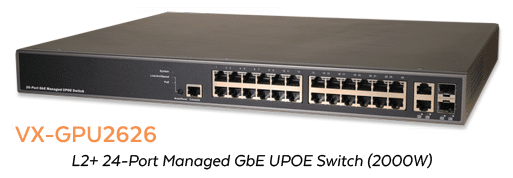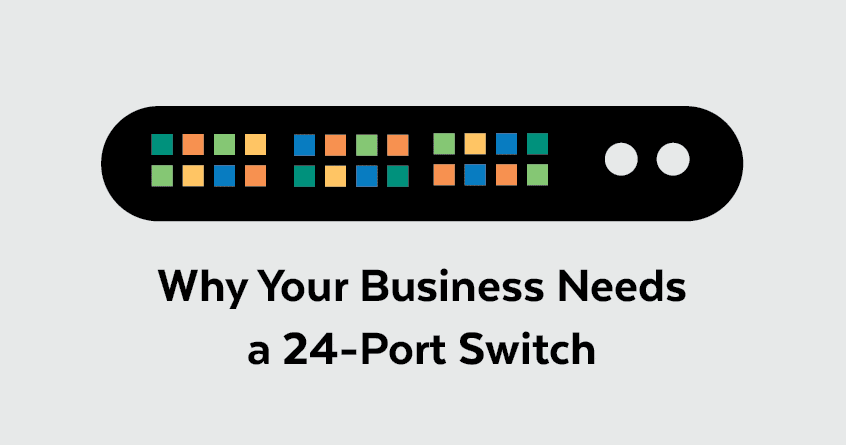An Ethernet switch is the backbone of a company’s network. It connects vital networking devices (laptops, computers, servers, etc.) to a local area network (LAN). Switches function similarly to a hub; however, they are more efficient. They accept incoming data, determine the IP address of its source, then assign a specific port, therefore eliminating any potential for network traffic “clogs.” This is a huge benefit for super dynamic business networks. The Ethernet switch is an essential piece of networking equipment for organizations of all sizes. While Ethernet switches are a vital part of an enterprise’s LAN, they are expensive, so it is important to invest in the correct type of switch to meet your business’s current and future needs. Organizations of all types most commonly opt for the 24-port Ethernet switch. This article will help you select the most suitable 24-port switch for your company.
Why do you need a 24-port switch?
Ethernet switches designed with 24 ports can connect multiple network devices. They provide a network infrastructure that is:
 Affordable
Affordable- Fast
- Optimized bandwidth
- Secure
- Stable
What types of 24-port switches are available?
When considering the purchase of a 24-port switch, there are several types to ponder. This article will discuss the following:
- Unmanaged vs. managed switches
- Regular vs. PoE switches
- Standalone vs. stackable switches
Unmanaged vs. Managed 24-Port Switches
Unmanaged Switch
An unmanaged switch has a fixed configuration that cannot be changed or controlled. This type of switch is often used in small networks or to add temporary systems groups to more extensive networks.
One advantage of an unmanaged switch is that it is a simple “plug-and-play” device that requires no setup. In addition, it has built-in QoS (Quality of Services) and fundamental security that includes lockable ports so no one can tamper with the device directly.
The price of an unmanaged switch depends on how many ports it has. However, a 24-port unmanaged switch is considerably less expensive than a managed one.
Managed Switch
In contrast, a managed switch can be managed, configured, and monitored. For example, LAN traffic can be controlled, specific channels can be prioritized, and VLANs (virtual local networks) can be created to segregate small groups of devices. Managed switches also offer redundancy features that duplicate and recover data in the event of a device or network failure.
Furthermore, managed switches have features like:
- Simple Network Management Protocol (SNMP) that enables troubleshooting and allows the implementation of issue fixes.
- Security protocols that keep unauthorized users out provide limited access to specific users, along with the ability to monitor and control security remotely.
When it comes to cost, managed switch prices are most influenced by the number and type of features they have. These more costly but feature-packed switches are most suitable for larger networks with data centers and need robust control over their network traffic.
 Regular vs. PoE 24-Port Switches
Regular vs. PoE 24-Port Switches
Regular Switch
The main difference between a regular switch and a PoE switch relates to Power over Ethernet (PoE) availability. A regular switch is a non-PoE device used to connect network devices that do not require a PoE function. A 24-port regular (or non-PoE) switch is the most cost-effective choice for a non-PoE network.
PoE Switch
PoE technology enables a 24-port switch to deliver both power and data over a single twisted-pair Ethernet cable. PoE switches connect PoE-compatible devices such as IP phones, wireless access points (WAPs), surveillance cameras, and much more. In addition, PoE allows endpoints to be easily placed in remote areas with no access to electrical wall outlets.
PoE technology has many benefits that include:
- Reduced costs: PoE saves money on power cables, power outlets, installation, and eliminates electrician costs.
- Flexible: PoE devices can be placed in remote locations and are easily moved or changed.
- Reliable: PoE relies on Ethernet, which is a wholly vetted technology. In addition, it is wired and, therefore, has limited interference and significant security features.
- Safe: PoE is intelligent and can be programmed to avoid overload and underload situations. In addition, PoE technology uses low wattage, which is inherently safe.
Standalone vs. Stackable 24-Port Switches
Standalone Switch
Standalone switches are managed and configured as a single unit; they cannot be connected to work as a single switch. These devices are commonly deployed in small business networks.
Stackable Switches
In contrast, stackable switches can be combined to act as a single switch. So, instead of managing eight standalone 24-port switches individually, eight 24-port stackable switches (with a combined 192 ports) can be managed as one switch.
Stackable switches simplify management while increasing a network’s capacity. As a result, these devices are suitable for large networks or data centers with limited space.
Why Versa Technology Recommends a 24-Port Managed PoE Switch For Your Business
In our opinion, a 24-port managed PoE switch is the optimal choice for most business applications.
Why?
First of all, switches come in models with four to 54 ports. The decision of which type to use boils down to the number of IoT devices your network supports. A switch with 24 ports supplies an adequate number of ports to support the immediate needs of a small or medium-sized company, with some ports left over to meet future needs. For larger enterprises that require more than 24 ports, they are simply cheaper, as two 24-port switches are cheaper than one 48-port switch.
Second, a managed switch is always your best bet if you can afford it. Unmanaged switches are “dumb,” and the advantages of a managed switch are numerous. With a managed switch, you can:
- Create VLANs and limit access to specific devices
- Use Layer 3 routing capabilities to link small networks to larger business-wide networks
- Take advantage of PoE technology
- Monitor network performance remotely
- Enhance security by managing each port individually
And last, the benefits of PoE technology in business applications are huge and include the ability to:
- Merge lighting, air, physical security, etc. into a single IP network
- Establish an agile network by transmitting both power and data over the same Ethernet cable
- Collect and analyze data
- And much more!
Versa Technology, Inc.’s unwavering mission since 1994 has been to market industry-leading networking products that are versatile, user-friendly, and cost-effective.
 Our C51-244-30-370 Managed 24-Port PoE Switch, pictured above, has the following features:
Our C51-244-30-370 Managed 24-Port PoE Switch, pictured above, has the following features:
- Ports: 24 10/100/1000TX shared 24 PoE + 2 GbE + 2 SFP
- Type of Switch: Managed
- PoE Ports: 24
- Standards: 802.3at/af
- PoE Power Budget: 370W
- Input Voltage: 100~240VAC
- Operating Temp: 0 to 50°C
- TAA Compliant, made in Taiwan

